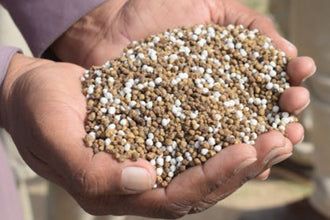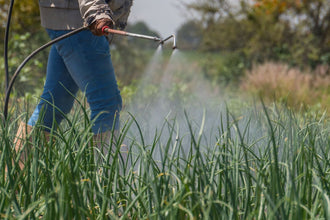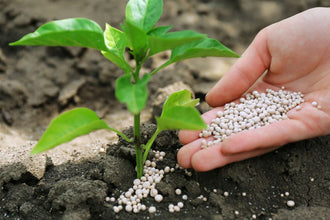
Slow release fertilizer has become the go-to choice for gardeners who want steady, consistent plant growth without the hassle of frequent applications. Unlike quick-acting synthetic options, these fertilizers work gradually over months, feeding plants at a pace that mirrors nature's own rhythm.
Most gardeners face the same frustrating cycle. They apply fertilizer, see a burst of growth, then watch their plants struggle as nutrients wash away. This boom-and-bust pattern stresses plants and wastes money. Slow release options break this cycle by providing a steady stream of nutrients that plants can actually use.
The secret lies in how these fertilizers are made. Special coatings or natural processes control nutrient release, preventing the feast-or-famine effect that damages root systems and stunts growth. Your plants get what they need when they need it, creating stronger, more resilient gardens.

How Slow Release Fertilizer Works
Understanding the science behind slow release fertilizer helps you make better choices for your garden. These products use several methods to control nutrient timing, each with its own benefits.
Coating Technology
Polymer-coated fertilizers wrap nutrients in a thin shell that breaks down over time. Temperature and moisture control the release rate, meaning plants get more food during active growing periods. Cool weather slows the process, while warm, wet conditions speed it up.
This smart system matches plant needs perfectly. Spring warmth triggers faster nutrient release just as plants start their growth spurt. Summer heat continues the process, while fall cooling naturally reduces feeding as plants prepare for dormancy.
Organic Breakdown Process
Natural slow release fertilizer relies on soil microbes to break down organic matter. Chicken manure, compost, and other organic sources must decompose before plants can access their nutrients. This biological process creates a naturally timed release system.
Soil temperature and moisture levels affect how quickly microbes work. Warm, moist soil speeds decomposition, while cold or dry conditions slow it down. This natural timing system has worked for thousands of years, long before synthetic fertilizers existed.
The bonus benefit comes from feeding soil microbes. These tiny organisms improve soil structure, help plants resist disease, and create a thriving underground ecosystem that supports long-term plant health.
Benefits of Using Slow Release Fertilizer
Switching to slow release fertilizer transforms how you garden and how your plants grow. The advantages go far beyond simple convenience, affecting everything from plant health to environmental impact.
Consistent Plant Growth
Plants fed with slow release fertilizer develop stronger root systems and more balanced growth. Instead of forcing rapid top growth that weakens plants, steady nutrition builds solid foundations that support long-term health.
Root development improves dramatically when nutrients arrive gradually. Plants invest energy in building extensive root networks instead of just pushing out leaves and stems. These deep, healthy roots help plants survive dry spells and resist disease pressure.
Leaf color stays consistent throughout the growing season. No more yellowing plants halfway through summer or the pale, weak growth that signals nutrient deficiency. Steady feeding keeps plants green and vigorous from spring through fall.
Reduced Application Frequency
Most slow release fertilizer products last 3-6 months, dramatically reducing garden maintenance time. One spring application often carries plants through the entire growing season, eliminating the need for monthly feeding schedules.
This extended release period saves both time and money. Fewer applications mean less product needed overall, and the improved efficiency means plants use more of what you provide. Less waste translates to better value and reduced environmental impact.
Timing becomes much more forgiving with slow release options. Missing an application window with quick-release fertilizers can set plants back for weeks. Slow release products provide a buffer that keeps plants fed even if you forget or go on vacation.
Environmental Protection
Slow release fertilizer dramatically reduces nutrient runoff that pollutes waterways. Quick-dissolving fertilizers often wash away before plants can use them, creating algae blooms and dead zones in lakes and streams.
The controlled release mechanism keeps nutrients in the root zone where plants need them. This targeted approach means more nutrition reaches your plants and less ends up in storm drains or groundwater supplies.
Soil health improves over time with organic slow release options. These products feed beneficial microbes that create better soil structure, improve water retention, and support the complex ecosystem that healthy plants depend on.
Types of Slow Release Fertilizer
Different types of slow release fertilizer work better for different situations. Understanding your options helps you choose the right product for your specific garden needs and growing conditions.
Coated Synthetic Options
Polymer-coated fertilizers offer precise control over nutrient release timing. These products typically last 3-6 months and provide consistent feeding regardless of organic matter levels in your soil.
Temperature sensitivity makes these fertilizers particularly useful in variable climates. Cold spring weather slows release when plants are dormant, while summer heat increases feeding during peak growing season. This automatic adjustment matches natural plant cycles.
The main drawback involves cost and soil health. While effective for plant nutrition, these products don't improve soil biology or structure the way organic options do.
Organic Slow Release Fertilizer
Natural materials like composted chicken manure provide slow release nutrition while building soil health. These products must decompose before releasing nutrients, creating a naturally timed feeding system.
Organic options feed soil microbes that improve plant immunity and root development. The biological activity these products create builds long-term soil fertility that synthetic options can't match.
Nutrient ratios in organic slow release fertilizer tend to be more balanced and complete than synthetic alternatives. Plants get trace minerals and secondary nutrients often missing from chemical formulations.
Blended Products
Many manufacturers combine coated synthetic nutrients with organic materials to capture benefits from both approaches. These blends provide immediate soil improvement plus extended feeding duration.
The organic component begins working immediately, improving soil structure and microbial activity. Meanwhile, coated nutrients provide extended feeding that carries plants through the growing season.
These combination products often cost more than single-source options but provide more complete plant nutrition and soil improvement.
Choosing the Right Slow Release Fertilizer
Selecting the best slow release fertilizer depends on your plants, soil conditions, and gardening goals. Several factors influence which type will work best in your specific situation.
Soil Type Considerations
Sandy soils drain quickly and need longer-lasting fertilizers to prevent nutrient loss. Coated products work well in these conditions because they resist leaching even with frequent watering.
Clay soils hold nutrients longer but may have drainage issues that affect organic decomposition. Blended products often work best in heavy soils, providing immediate benefits plus extended feeding.
Testing your soil pH helps determine which slow release fertilizer will work most effectively. Some products work better in acidic conditions, while others prefer neutral or slightly alkaline soil.
Plant Requirements
Different plants have varying nutrient needs throughout their growing cycles. Vegetables need consistent feeding during production, while established perennials may need less intensive nutrition.
Annual flowers benefit from steady feeding that supports continuous blooming. Slow release fertilizer prevents the nutrient interruptions that cause flowering to slow or stop.
Trees and shrubs prefer gentle, consistent feeding that won't stimulate excessive growth. Overfed woody plants become weak and susceptible to disease and winter damage.
Climate Factors
Hot, humid climates accelerate both organic decomposition and coated fertilizer release. You may need products with longer release periods in these conditions.
Cold climates slow nutrient release from all types of slow release fertilizer. Spring applications may need supplementing with quick-release options to jump-start growth in short growing seasons.
Rainfall patterns affect how well different products work. Areas with heavy spring rains need fertilizers that resist washing away, while dry climates may need products that release nutrients even with limited moisture.
Application Tips for Maximum Results
Getting the best results from slow release fertilizer requires proper application timing and technique. Following a few simple guidelines ensures your plants get maximum benefit from these products.
Application timing matters more with organic slow release fertilizer than synthetic options. Spring application allows time for decomposition before peak growing season begins.
Work granular products into the top few inches of soil rather than just scattering on the surface. This placement puts nutrients where developing roots can find them and reduces losses to wind and rain.
Water thoroughly after application to activate the release process. Moisture starts the breakdown process in organic products and begins the coating dissolution in synthetic options.
Monitor plant response throughout the season to evaluate effectiveness. Consistent green color and steady growth indicate proper nutrition levels, while yellowing or slow growth may signal the need for supplemental feeding.
Fancy Chicken Organic Pelletized Chicken Manure: Premium Slow Release Nutrition
The Natural Advantage of Chicken Manure Pellets
Fancy Chicken organic pelletized chicken manure represents the perfect marriage of traditional organic gardening and modern convenience. This premium product delivers the slow release benefits gardeners love while eliminating the mess and odor associated with fresh chicken manure. The pelletized form breaks down gradually over 8-12 weeks, providing steady nutrition that mirrors how plants naturally receive nutrients in the wild.
Unlike synthetic slow release fertilizers that rely on chemical coatings, Fancy Chicken pellets use nature's own decomposition process. Soil microbes gradually break down the organic matter, releasing nutrients at a pace that plant roots can efficiently absorb. This biological process creates a naturally timed feeding system that's been perfecting itself for millennia.
The concentrated pellet form makes Fancy Chicken manure incredibly easy to store and apply. Each pellet contains balanced nutrition that won't burn plants even with generous application, giving you confidence to feed your garden without worry about over-fertilization damage.
How Fancy Chicken Creates Long-Term Soil Health
This organic slow release fertilizer works on two levels that synthetic options simply can't match. While feeding your plants, Fancy Chicken pellets simultaneously improve soil structure and biology for long-term garden health.
Key slow release benefits:
-
8-12 week gradual nutrient release eliminates frequent reapplication
-
Natural NPK balance promotes steady, sustainable plant growth
-
Organic matter improves soil water retention and drainage
-
Feeds beneficial microbes that support plant immunity
-
Won't leach away with heavy rainfall like liquid fertilizers
-
Safe for children, pets, and beneficial insects
The microbial activity generated by decomposing chicken manure creates a thriving soil ecosystem. These beneficial bacteria and fungi form partnerships with plant roots, improving nutrient uptake and disease resistance. This living soil approach builds garden health that lasts for years, not just one growing season.
Smart Application Strategies for Best Results
Apply Fancy Chicken pellets in early spring before active growth begins, allowing time for initial decomposition to start the slow release process. Work the pellets into the top 3-4 inches of soil around established plants, or mix them into planting beds before seeding.
Application timing for optimal results:
-
Early spring: Apply 4-6 weeks before last frost date
-
Mid-season boost: Light application for heavy feeders like tomatoes
-
Fall preparation: Apply 6-8 weeks before first expected frost
-
New plantings: Mix into soil at transplanting time
The pellets need consistent moisture to activate properly, so time applications before expected rainfall or plan to water thoroughly afterward. Unlike quick-release fertilizers that can wash away with the first heavy rain, these pellets stay put and continue working through wet weather.
Maximizing Your Investment in Organic Nutrition
Start with the package-recommended rate and adjust based on your plants' response and soil conditions. Vegetables and annual flowers typically need the full recommended amount, while established perennials and trees often thrive with lighter applications.
Store unused pellets in a dry location to maintain their slow release properties. The pelletized form remains stable for years when kept moisture-free, making bulk purchases economical. Unlike liquid fertilizers with expiration dates, Fancy Chicken pellets improve with age as they cure.
Most gardeners find one spring application of Fancy Chicken pellets carries their gardens through the entire growing season, with perhaps a light mid-summer boost for heavy feeders. This convenience factor, combined with superior plant performance, makes organic pelletized chicken manure an excellent long-term investment in garden health.
Ready to Transform Your Garden?
Slow release fertilizer offers a smarter approach to plant nutrition that saves time while improving results. Your plants will develop stronger root systems, maintain better color, and show more resistance to stress and disease.
The investment in quality slow release products pays dividends in reduced maintenance time and better garden performance. You'll spend less time mixing and applying fertilizers and more time enjoying a thriving, healthy garden that looks great all season long.








